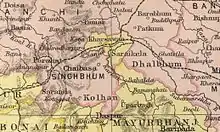Kolhan was a territory administered by the British Raj in Singhbhum District in Bihar with an area of 5,063 km². It was the country of the Ho (Larka-kols) group of the Kols.[1][2][3] The population in 1872 was 150,904 people distributed in 883 villages. It is currently situated in the state of Jharkhand.

In modern times, the Hos, Mundas, Bhumijs, Oraons and other aboriginal communities of Kolhan regions has demanded the formation of its own independent nation, Kolhan state or Kolhanistan.[4][5]
Etymology
Kolhan gets its name from the aboriginal Kol inhabitants of the Singhbhum district. It is also known as the land of Kols (Hos or Larka-Kols).
History
Early period
Kolhan region was part of the Singhbhum district and was under the jurisdiction of the Raja of Porahat. Larka-Kols and Bhumij Kols were the first settlers of the region of Singhbhum. Singhbhum was named after their supreme god 'Singbonga' and Kolhan as the homeland of Kols.[6][7]
British period
British relations with the area began in 1820 when it was a refuge for fugitives from Chhota Nagpur; the Hos made incursions into neighboring territories much to the annoyance of the Raja of Porahat (or Sanjai-Porahat) and the landlords of northern Singhbhum (the zamindars of Kharsawan and Saraikela). The British government made a treaty with the Raja of Porahat and helped him (and also the Rajas of Saraikela and Kharsawan) against the Hos (1821), but they did not achieve the final purpose.
In 1836, the British government, following the advice of Captain Wilkinson, head of the South-West Frontier Agency (SWFA), decided to take the territory under its direct control. Colonel Richards entered the country with a significant force and secured the submission in 1837 of the Mundas and Mankis, who dominated 620 villages. With the territory and some Ho (or Kol) majority parganas belonging to Raja of Singhbhum or of Mayurbhanj, the separate territory of Kolhan was formed with capital at Chaibasa. The Mankis, head of the pirs (panchayat), were the in charge of the police and tax collectors of the Mundas and the Mundas were the head of the villages. There were no more incidents of insurrection until 1857 when the Hos joined the rebellion of the Raja of Porahat; the campaign to subdue the revolt of the Raja and the Hos ended in 1859.
Kolhan statehood movement
In 1952, thousands of Adivasis (aboriginals) from the Munda, Ho and Oraon and other groups in Bihar demanded a sovereign and independent nation called Kolhan. On October 30, 1977, the leaders of the Ho tribe, the Mundas and the Mankis (Kolhan-Porahat Munda-Manki Sangh) met in assembly. On November 1, 1977, tribal leaders Narayan Jonko, Christ Anand Topno and K.C. Hembrom formed the Kolhan Raksha Sangh (also referred to as Kolhan Raksha Samiti), with Jonko as president and Hembrom as secretary. On 30 March 1980, the party organized a massive tribal demonstration at Mangla Hat in Chaibasa to declare Kolhan statehood; according to the party, the district was never part of the British India and was therefore an independent state. The movement proclaimed independence on September 21, 1981, and declared a National Day on December 2, 1981, anniversary of the proclamation of the Wilkinson government, basis for ensuring that the territory was not part of British India; a letter was also sent to the headquarters of the Commonwealth in London, signed by Narayan Jonko, titled head of Government of Kolhan. Jonko and Anand Topno visited London and Geneva presenting the case of the Kolhans. The Indian government arrested the Kolhan leaders in October and November 1981. The party began a campaign of terror against the opposition led by the politician and schoolteacher K.C. Hembrom, who ratified the proclamation of the independence of Kolhanistan, proclamation to which a great number of adventurers joined, but which was not effective; actions caused 8 deaths in Tonto market. It was the Kolhan Raksha Sangh (KRS) that designed a national flag of Kolhan and proclaimed independence, declaring September 21 (as of 1982) as the 'National Day of Kolhan'.
The tribal Kols of Bihar again demonstrated violently in favor of independence in March 2000. The movement for a sovereign Kolhan nation resumed again in 2015 in the tribal district of West Singhbhum, 4 years after the formation of Jharkhand.
References
- ↑ Department, Bengal (India) Land Records and Agriculture (1898). Final Report on the Settlement of the Kolhan Government Estate in District Singhbhum. Bengal Secretariat Press.
- ↑ Prasad, Chandra Bhushan (1970). Final Report on Survey and Settlement Operations in the District of Singhbhum, 1958-1965. Superintendent, Secretariat Press, Bihar.
- ↑ Sinha, S. P. (1993). Conflict and Tension in Tribal Society. Concept Publishing Company. ISBN 978-81-7022-493-8.
- ↑ Sinha, S. P. (1993). Conflict and Tension in Tribal Society. Concept Publishing Company. ISBN 978-81-7022-493-8.
- ↑ Reichel, Eva (2020-08-10). The Ho: Living in a World of Plenty: Of Social Cohesion and Ritual Friendship on the Chota Nagpur Plateau, India. Walter de Gruyter GmbH & Co KG. ISBN 978-3-11-066625-0.
- ↑ "Bihar District Gazetteers: Singhbhum". INDIAN CULTURE. Retrieved 2023-09-17.
- ↑ O’malley .l. S.s. (1910). Bengal District Gazetteers Singhbhum, Saraikela And Kharsawan.